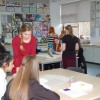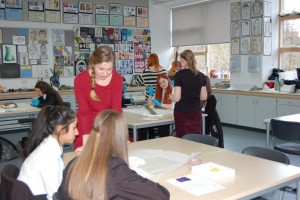
by Fiona Wain, 2nd year student, MPhil Textile Conservation.
As part of our Professional Development course in the 2nd year we work on our public engagement skills by giving talks to different groups in the community. This year talks were delivered to two 3rd year art classes at Eastwood High School, Newton Mearns, and one special interest textile group. I and my classmate, Cecilia Voss, gave our talk to one of the 3rd year art classes. Our job was to show the students the combination of subjects that we use every day in conservation.
This was a daunting task, as it is a long time since we were at school! We wanted the talk to be both informative and interesting to the students, and we decided that to do this we would not only need to explain about textile conservation, but follow this up with a group activity in which the students would be able to handle historical objects.
We managed to put our nerves to one side, and after a slight mishap with our PowerPoint presentation at the start of our talk everything went smoothly. After a brief overview of what textile conservation is: caring for textiles for the benefit of future generations, we explained how our backgrounds differed before studying textile conservation – textile design and classics! Our different backgrounds, strengths, and viewpoints enable us to help each other and through class discussions learn from each other.
In order to give the students some context we showed how many of the subjects studied in school make up part of textile conservation:
- History
- Chemistry
- English
- Art
- Design Technology
- Maths
- and sometimes P.E.!
These subjects are the background and the story behind the objects we treat, the degradation and treatment of fibre types, the documentation we write, the diagrams we draw, the mounting forms we make, the precise dye and chemical calculations, and occasionally re-arranging tables and working as a team to manoeuvre large, or heavy objects.
We talked the students through some of the projects that we have worked on, each covering different conservation treatments and object mounting techniques. The information in this section of the talk was aimed to encourage the students to think about how a conservator would treat the historical objects the students would get to look at and handle later in the session.
We took objects from the Centre for Textile Conservation’s reference collection for the students to handle and think about their history, what has caused any degradation, and how a conservator would treat them. The class was split into five groups; each group had a different object and answered set questions about them. This gave the students the opportunity to handle objects that they would not normally come into contact with.
Images@University of Glasgow and courtesy of Eastwood High School
Engaging in the talks gave a real boost in confidence, especially because of how well they were all received. It was also an exercise in tailoring the presentations to the particular groups we were addressing. Giving these presentations gave me and my colleagues the opportunity to talk to different groups including those that did not know about conservation, and hopefully inspired interest in a career in conservation.
Frances Lennard adds:
We were delighted to learn afterwards that Eastwood High School was on a shortlist of three for a Scottish Education Award in STEM (science, technology, engineering and maths). The assessors were interested to hear about the textile conservation students’ sessions at the school, and I was invited to go along and talk to them during their assessment visit. It’s very pleasing that the partnership with Eastwood, now in its second year, benefits both the school and the university students so much.





